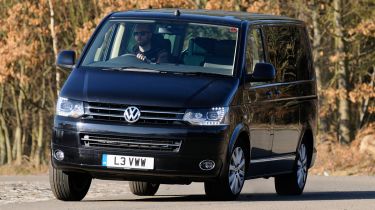VW Caravelle SE BiTDI DSG
The smart-looking VW Caravelle is as classy as ever, despite its advancing years
Time has finally caught up with the evergreen Caravelle. It still feels classy inside and the engine and gearbox work beautifully together, but it can’t come anywhere near the Ford for practicality or on-board technology. Yet it’s the ageing chassis and sky-high price that really put the VW’s second place beyond doubt in this encounter.
The current-generation Caravelle went on sale in the UK a decade ago this year and, although it was given a major facelift in 2009, it will have its work cut out to beat the new Tourneo in this test.
Yet it strikes the first blow here, thanks to a timeless exterior design that’s far classier than the ungainly Ford’s. Compact dimensions and a lower roofline combine with a two-bar chrome grille and 17-inch alloys to move the VW away from its commercial cousins.
Admittedly, the eye-wateringly expensive Business Edition in our pictures gets some extra glitz that you won’t find on the SE model we tested. But even without the LED running lights and privacy glass, the simplicity of the design is the Caravelle’s biggest strength.
Inside, it pulls even further in front. Despite its age, the cabin is plusher and more welcoming than the Ford’s thanks to better dash materials and a car-like driving position. An excellent layout means finding a comfortable seating position takes seconds and, while you sit lower down than in the Tourneo, all-round visibility is superb.
Used - available now

2021 Land Rover
Range Rover
27,750 milesAutomaticDiesel3.0L
Cash £49,995
2022 BMW
3 Series Touring
52,456 milesAutomaticDiesel2.0L
Cash £23,800
2018 Mazda
6 Saloon
48,985 milesAutomaticPetrol2.0L
Cash £12,600
2023 Mercedes
EQC
55,207 milesAutomaticElectric
Cash £22,300Where the Caravelle does slip up, though, is on equipment. You get essentials such as electric windows and air-con as standard, but pay extra for kit like Bluetooth (£230), parking sensors (£420) and heated seats (£275) – all of which is included on the cheaper Tourneo.
Things look even worse for the VW once you slide open the side doors – which can be electrically powered for £650 – and climb into the back seats. The model in our pictures came with four rather than the usual five seats, but even so the low roof and narrow cabin make it feel cramped compared to the Ford. Also, those on board get a lot less room to stretch out in the Caravelle, there’s only room for seven and the seats are cumbersome. Still, they slide and rotate, there’s a removable circular table and the rear row of seats slides forward to improve the luggage area.
On the road, the 2.0-litre twin-turbo engine is a very smooth performer, especially in combination with the effortless seven-speed DSG box. The VW was 6.6 seconds quicker than the Ford from 50-70mph in sixthgear, taking 10.6 seconds. It comfortably outperformed its rival in our braking tests, too.
But on the road the Caravelle shows its age, as it crashes over potholes and speed bumps, and rolls heavily into tighter corners. The steering provides little feedback and the handling doesn’t inspire confidence, although this will be a secondary concern for most.
What will be important are running costs – and the VW returned a poor 21.2mpg in our hands. Combine that with the fact it sits two tax bands higher than its rival and costs £6,205 more, and it looks to be in trouble.







